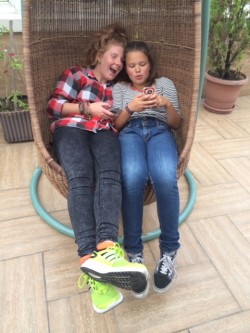One of the best things about participating in the Internet Governance Forum is seeing the growing youth participation in sessions about their online protection. And one of the best things I’ve heard so far, after just 1.5 days of the IGF here in Istanbul this week came from Danish 15-year-old Olivia in a session about “Child Online Protection” where there was much discussion about technical, legal and parental control of children’s Internet experiences:

“This is our world, the Internet we’re talking about here. You have to be with us in the world. You can’t keep us away from it. You have to talk with us about it…. You have to help your children instead of trying to control them [emphasis hers].”
Safety takes practice
This was in response to the moderator asking for a teen participant’s perspective on the discussion up to that point. Olivia later told us of a friend whose 3rd-grade teacher – someone who was “qualified,” i.e., literate in the technology and media popular with her students at that time – led a discussion with her students about how they felt people should treat each other online. Her friend told her “there haven’t been any [cyberbullying] problems since” that discussion. Her point was, young people need and want thoughtful, caring guidance from informed adults, and that, not restriction, is what keeps youth safe – that as well as their own growing resilience and literacy, of course (see below for more on the literacy part). There hasn’t been enough discussion, much less acknowledgment, in online-safety circles about young people’s own skills in keeping themselves and peers safe in connected media.
“Safe” is what’s felt in a community of guided practice, whether it’s a family or a school (if children aren’t fortunate enough to have this at home, it needs to happen at school and in digital environments). This is sound, child-centered safety education: when students receive respectful guidance through facilitated discussion and opportunities to practice what they learn (in digital environments, where digital safety’s concerned), knowing that caring adults are there when backup’s needed. We need more communities of guided practice online too – that’s what children’s virtual worlds and online games need to be.
Participation an established right
Olivia’s view is supported by her peers in other countries calling for more “positivity” in adults’ messaging about them and their media use, by researchers (see this and this), and by the best thinking from other adults as well – for example, in calls by more and more educators, risk prevention specialists and a recent national task Force for digital, media and social literacy education for all youth for their wellbeing online and offline.
And both her view (on a right to education over restriction) and the voicing of it are supported by the UN Convention on the the Rights of the Child, which has been ratified by almost every country on the planet and which holds that young people’s views must be “taken into account” in decisionmaking that affects them (Article 12; see this for more on the Convention vis. Internet safety. There is no more important stakeholder in a multistakeholder discussion about youth online safety than youth.
Related links
- See this for more on what kind of literacy is needed for the very social digital media we’re all using now.
- “Important granularity on Net risk for teens”
- A study by British education watchdog Ofsted way back in 2010 said something very similar about how providing skills in and with digital media rather than blocking it is better.
- “Cross-cultural in so many ways: Insights from ‘Digitally Connected'”
- “Balancing external with internal Internet safety ‘tools'”

[…] “This is our world, the Internet we’re talking about here. You have to be with us in the world. You can’t keep us away from it. You have to talk with us about it…. You have to help your children instead of trying to control them.” (Quote courtesy of NetFamilyNews.org) […]